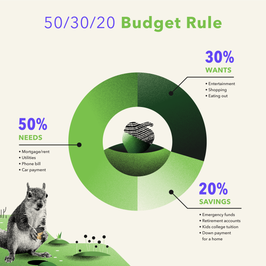What is Zero-Based Budgeting?

Creating a budget pulls double duty—it serves as an actionable plan for your money and it reduces financial stress. Don’t believe it? More than 50 percent of people who follow a budget say doing so makes them feel more confident, secure and in control, according to a recent survey from the CFP Board.
There’s no shortage of tools out there that make budgeting a little easier, from digital apps to the old-school pen-and-paper approach. The truth is that there isn’t one right or wrong way to do it. The key to creating a successful budget is finding a strategy that gels with your personality and spending habits.
For many, the answer is zero-based budgeting. Here’s how it works.
What is zero-based budgeting?
It’s all in the name. Zero-based budgeting (sometimes called zero-sum budgeting) assigns a job to every dollar you bring home. Think of it as spending your money in your head before you get the chance to spend it in real life. It’s essentially a plan for how you’ll spend every dollar of your paycheck until the balance gets down to zero. The idea is to prep for every expense, leaving no room for overspending.
How does it work in real life?
Once your paycheck hits your bank account, take a good look at the total. This is the money you have to work with before your next payday. Now list out all the bills you have during this pay period, starting with your fixed expenses. This includes your rent/mortgage, car payment, groceries, phone bill and so on—basically anything you can’t get around paying.
Now move onto your financial goals. Whether it’s saving up for your next big vacation, paying down credit-card debt, or gradually setting money aside to buy a home, these are dreams that won’t come to pass unless you start taking baby steps now. Settle on a per-paycheck savings target that feels right to you, then jot it down under your fixed expenses.
Whatever’s left can be earmarked for discretionary spending (i.e. the fun stuff). Entertainment, shopping, going to the movies—list out all of the spending you do during a typical pay period. Pro tip: giving your bank statement a quick once-over can help fine-tune things. Go back several months to get a good grasp on your spending behavior. For instance, you might notice that you spend way more on entertainment than you thought. Figure out your average spend in each category and write it down.
Keep deducting, line for line, until you eventually get to zero. You can do this on a spreadsheet or with a pen and paper; whatever works for you. What you see in front of you is your spending guide until your next paycheck comes in. You may find yourself staring at a negative number, but don’t freak out. (Remember, you haven’t actually spent this money yet. It’s just a dry run.)
Let’s pretend you’re $150 in the red. To make up for it, you may have to reduce the dollar amount you’d assigned to another category. Make some tweaks and shuffle your dollars around until you’re at a comfortable zero. If you find yourself making cuts to your financial goals, it’s time to reevaluate things.
Think outside the box when it comes to reducing your expenses. Negotiating things like your car insurance, internet bill and cable package could free up enough money to cover the gap. Your other alternative is upping your income. If a pay raise is off the table, consider getting in on the gig economy and picking up a side hustle.
Who is zero-based budgeting good for?
Zero-based budgeting is ideal for those who need a visual reminder of where they are financially. Seeing your money in black and white like this simplifies the whole budgeting process because you’re leaving no financial stone unturned—all of your expenses should be on the list. Building your budget on a digital spreadsheet and hitting the auto-sum button makes things even simpler. You can take things a step further by automating as many of your bills as possible.
This approach to budgeting is particularly useful for chronic overspenders because you know exactly how much you can spend in any given category. If you’ve budgeted $175 for eating out, you know that once that money’s gone, it’s gone. Freeing up more money in one area also requires cutting back in another, making you more mindful of wasteful spending.
It may take a few paychecks to get used to zero-based budgeting, but many find their footing soon enough. Having weekly money check-ins with yourself can help iron out the kinks. Did you go over budget in any one area? If so, ask yourself why. It could be that your target spending amount is unrealistic, or you encountered an unexpected pop-up expense that threw your budget out of whack. (A healthy emergency fund is your best defense here.)
Does zero-based budgeting have any drawbacks?
It depends on how organized you are. Zero-based budgeting is most effective for folks who take the long view and plan accordingly. If you aren’t prepared, non-monthly expenses can throw a wrench in your budget. These are bills that come up sporadically throughout the year—things like insurance premiums, holiday shopping and any other spending that isn’t a regular fixture on your monthly budget.
Back up and think about the non-monthly expenses you’ve encountered over the last year. Now add up your total spend, divide it by 12 and tack it onto your new budget. A $1,200 annual car insurance premium now becomes a $100 fixed expense. Treat it like an ordinary bill and move it into your savings account for safekeeping.
A solid emergency fund is vital to any working budget, but perhaps even moreso when embracing a zero-based budget. Despite our best intentions, it’s impossible to predict every single expense that’ll come our way. A great hack is to keep a little buffer of cash in your checking account to give yourself some breathing room.
Like anything else, zero-based budgeting has its pros and cons. Folks who aren’t keen on winging it when it comes to discretionary spending might find comfort in this budgeting system because it provides very clear boundaries. It also creates a built-in roadmap for hitting long-term financial goals. And that’s a goal worth striving for.
This material has been presented for informational and educational purposes only. The views expressed in the articles above are generalized and may not be appropriate for all investors. The information contained in this article should not be construed as, and may not be used in connection with, an offer to sell, or a solicitation of an offer to buy or hold, an interest in any security or investment product. There is no guarantee that past performance will recur or result in a positive outcome. Carefully consider your financial situation, including investment objective, time horizon, risk tolerance, and fees prior to making any investment decisions. No level of diversification or asset allocation can ensure profits or guarantee against losses. Article contributors are not affiliated with Acorns Advisers, LLC. and do not provide investment advice to Acorns’ clients. Acorns is not engaged in rendering tax, legal or accounting advice. Please consult a qualified professional for this type of service.








